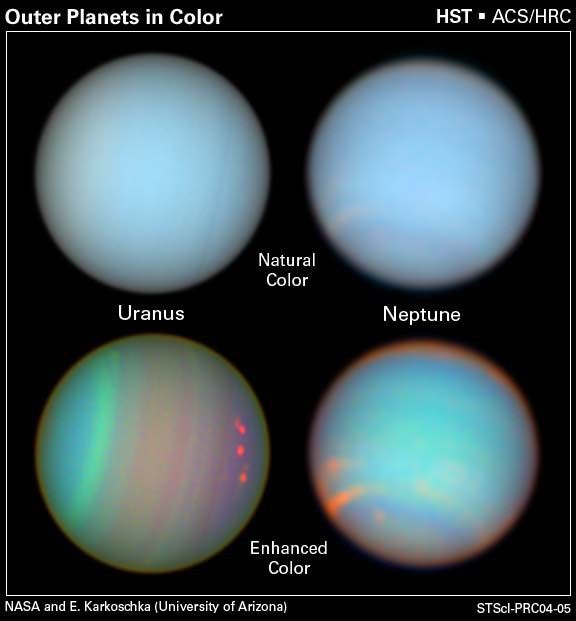1 min read
Rings and Moons Circling Uranus

This wider view of Uranus reveals the planet's faint rings and several of its satellites. The area outside Uranus was enhanced in brightness to reveal the faint rings and satellites. The outermost ring is brighter on the lower side, where it is wider. It is made of dust and small pebbles, which create a thin, dark, and almost vertical line across the right side of Uranus (especially visible on the natural-color image).
The bright satellite on the lower right corner is Ariel, which has a snowy white surface. Five small satellites with dark surfaces can be seen just outside the rings. Clockwise from the top, they are: Desdemona, Belinda, Portia, Cressida, and Puck. Even fainter satellites were imaged in deeper exposures, also taken with the Advanced Camera in August 2003.
About the Object
- DistanceDistanceThe physical distance from Earth to the astronomical object. Distances within our solar system are usually measured in Astronomical Units (AU). Distances between stars are usually measured in light-years. Interstellar distances can also be measured in parsecs.The semi-major axis of Uranus's orbit about the sun is 19.18 Astronomical Units (A.U.) or roughly 2.9 billion km.
- DimensionsDimensionsThe physical size of the object or the apparent angle it subtends on the sky.Uranus (without rings) has a diameter of roughly 32,000 miles (51,000 km) at the equator.
About the Data
- Data DescriptionData DescriptionProposal: A description of the observations, their scientific justification, and the links to the data available in the science archive.
Science Team: The astronomers who planned the observations and analyzed the data. "PI" refers to the Principal Investigator.The Uranus ACS/HRC data are from the HST proposal 9725: E. Karkoschka and M. Tomasko (U. AZ) The Uranus STIS/CCD data are from the HST proposal 9035: E. Karkoschka (U. AZ), M. Lemmon (Texas A&M), M. Tomasko (U. AZ) Note: Uranus images within this press release were taken with ACS/HRC. They were color calibrated using STIS/CCD data of Uranus. - InstrumentInstrumentThe science instrument used to produce the data.HST>ACS/HRC and HST> STIS/CCD
- Exposure DatesExposure DatesThe date(s) that the telescope made its observations and the total exposure time.August 19, 2002 and August 30, 2003
- FiltersFiltersThe camera filters that were used in the science observations.ACS/HRC: F435W, F550M, F658N, F660N, F775W, F814W, F850LP, and F892N STIS/CCD: G430L and G750L
- Object NameObject NameA name or catalog number that astronomers use to identify an astronomical object.Uranus
- Object DescriptionObject DescriptionThe type of astronomical object.Planet
- Release DateJanuary 22, 2004
- Science ReleaseThe Colorful Lives of the Outer Planets
- CreditNASA and Erich Karkoschka, University of Arizona

Related Images & Videos

The Colorful Lives of the Outer Planets
Atmospheric features on Uranus and Neptune are revealed in images taken with the Space Telescope Imaging Spectrograph and the Advanced Camera for Surveys aboard NASA's Hubble Space Telescope. The observations were taken in August 2003. The top row reveals Uranus and Neptune in...
Share
Details
Claire Andreoli
NASA’s Goddard Space Flight Center
Greenbelt, Maryland
claire.andreoli@nasa.gov


































